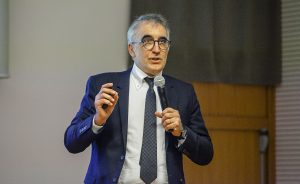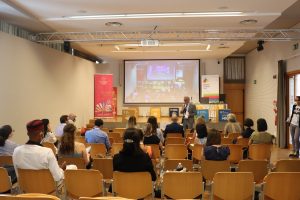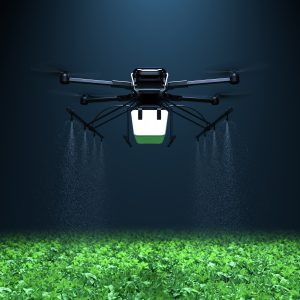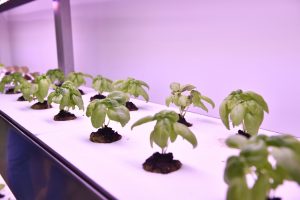The interdisciplinary experience of Santa Chiara Lab
Sixt year of activity, with over 200 funded projects, more than 2000 research units involved for a total value of €289 million: PRIMA Foundation is the Euro-Mediterranean program for agrifood research and innovation in the Mediterranean, whose Italian secretariat is based at Santa Chiara Lab of the University of Siena with the task of spreading the initiative in Italy and promoting participation in calls for tenders involving research bodies, universities, and enterprises.
The measurement and traceability of the sustainability and origin of agrifood productions is also the main goal of Spoke 9 of the National Agritech Center, a project funded by the PNRR and led by Santa Chiara Lab.

Professor Angelo Riccaboni, president of the PRIMA Foundation and coordinator of Spoke 9, talks us about the genesis and developments of two important and complex research projects in the agrifood sector.
How was the PRIMA program born and what was the path for establishing the PRIMA Foundation in Barcelona? What kind of support the Italian Prima Secretariat got for the innovation projects launched by the Foundation?
The PRIMA initiative (Partnership for Research and Innovation in the Mediterranean Area) represents the most ambitious Euro-Mediterranean scientific cooperation program ever undertaken which supports research and
innovation projects and solutions on sustainable in the Mediterranean basin. The program is focused on agri-food systems water resources management, farming systems, the agrifood value chain and the nexus among water, food and energy (WEFE). It aims to promote sustainable agri-food systems and to develop innovative solutions in order to supporting well-being and inclusive socio-economic development in the Mediterranean within a context of enhanced Euro-Mediterranean cooperation. The PRIMA Foundation, chaired by me, is jointly promoted by the European Commission and 19 Euro-Mediterranean countries, 11 EU members (Cyprus, Croatia, France, Germany, Greece, Italy, Luxembourg, Malta, Portugal, Slovenia and Spain), and 8 non-EU members (Algeria, Egypt, Jordan, Israel, Lebanon, Morocco, Tunisia and Turkey).

Italy has played a leading role in the development of the PRIMA program. Our country, in fact, has taken on a coordinating role since 2014 both in the elaboration of the joint program, and in the process of assessing the impacts of the PRIMA initiative that led to the positive opinion expressed by the European Commission in July 2016, subsequently approved by the European Council and the
European Parliament. PRIMA was launched during an inter-ministerial conference about the Mediterranean in Malta in spring 2017 and it was formally adopted at the end of May 2017.
The PRIMA initiative operates through an implementation structure (PRIMA-IS Foundation) based in Barcelona. The participating countries and the Commission committed equally to the implementation of the Program with about €500 million, to be dispensed over 7 years, through competitive tenders according to the criteria of Horizon 2020. For the implementation of the initiative, a Foundation under Spanish law was set up with headquarters in Barcelona (PRIMA Foundation), at the Union for the Mediterranean, in charge of managing the tenders, and co-chaired by me and Professor Mohamed El-Shinawi. Thanks to the contribution of the Ministry of University and Research, the Italian PRIMA Secretariat was set up at the Santa Chiara Lab – University of Siena, in charge of carrying out PRIMA Program’s promotion and publishing in our country.
Since 2018, 6 Annual Work Plan have been launched on which Italy has made a constant contribution through the Secretariat and together with the most important Italian universities and research centers.
A research idea alone is not enough to turn into a project, it seems. How does a research idea evolve? How do you get to the job of the researcher?
Certainly, a good project idea is not enough to make a research project win and obtain the necessary funding for its development. A project needs a consolidated collaboration network, a good research activity, as well as a part of industrial development.
Creating a project requires an already active and consolidated starting point, already tested collaborations that can respond to a project proposal. Only by building a good design structure you can respond effectively to a research proposal.
For about a year you have been coordinating Spoke 9 of the National Agritech Center, a project funded by the PNRR about “Measurement, certification and enhancement of the quality, origin, typicality, safety and sustainability of products, processes, supply chains and agri-food companies”. For the research activities of Spoke 9, the Santa Chiara Lab manages a budget of €40
million, of which €11.7 million is allocated to the University of Siena and it includes 13 affiliates among universities, research institutions and companies. These are huge economic resources, with many actors and human resources involved: can you describe the instruments, the synergies, the essential and complementary elements that have allowed then and still allow to investigate the same theme and to manage and make a project concrete. Can you tell us about the specific case of Spoke 9 Agritech?

The National Agritech Center proposed by the University of Naples Federico II as a hub (implementing subject), has identified nine Spokes (research executing subjects) entrusted to nine Universities and Research Centers with the task of implementing five macro-objectives: improving sustainable productivity and promoting resilience to climate change; reducing waste and environmental impact; developing circular economy strategies; sustainable development of marginal areas; promoting safety, traceability and typicality in the agri-food chains. The referents of the nine Spokes selected by the Agritech Center are: CNR, University of Padua, University of Aldo Moro (Bari), University of Federico II (Naples), University of Tuscia, University of Milan, University of Bologna, University of Turin, University of Siena.
In particular, the University of Siena, with the Santa Chiara Lab, oversees Spoke n.9 on the origin and traceability of products and processes, and measurement of sustainability of supply chains and agri-food companies. The Spoke, coordinated by me, also involves, among others, the University of Pisa, the University of Florence and Enea with the aim of creating a widespread laboratory
“METRIQA” in which scientific research and new information technologies will be able to provide an essential contribution to the new dimensions of production quality, through innovative solutions for process traceability, measurement, certification and promotion of the origin and sustainability of products, processes, supply chains and individual companies.
Research and innovation projects, specific solutions, educational activities, training, technology transfer, events: the Santa Chiara Lab, as an innovation center, promotes all these initiatives within the framework of sustainability, pursuing the Objectives of the UN 2030 Agenda. How important are networking, relationships and interdisciplinarity to create the premise whereby
an idea can be developed, from the essential perspective of sustainability?
The Santa Chiara Lab – University of Siena is the Sienese university’s center for interdisciplinary innovation focused on sustainability, the agri-food sector, digital technologies, education, public health, cultural diplomacy, financing help.
Since 2018, the Santa Chiara Lab has hosted the Italian Secretariat of PRIMA with the task of promoting the program on the national territory; as I explained above, within the PNRR National Agritech Center, the center is at the helm of Spoke 9.

There are also numerous technology transfer activities and projects aimed at promoting digital transformation and the application and integration of technologies to production processes. Among these, Siena Food Lab, the joint initiative of the Santa Chiara Lab and the Monte dei Paschi di Siena Foundation, which recently became the ETS Foundation (Third Sector Organization), for innovation in the agricultural sector of the province of Siena and the correlated Siena Food Lab Academy, an advanced training course on innovation in the sector. “Imprese 2030” and Santa Chiara Next (spin-off of the University of Siena) are focused on supporting companies in
measuring and evaluating their degree of sustainability. The center also makes available the hydroponic laboratory which allows to experience live the advantages of indoor farming and soilless crops.
It’s been a while since the Santa Chiara Lab has been having a strong collaboration with the Italian Alliance for Sustainable Development on numerous research activity, study and dissemination, in particular with the Working Group ASviS on Goal 2 (zero hunger), for which I have the role of co-coordinator. Since 2018, in collaboration with ASviS, SDSN, the network promoted by the United Nations and led by Professor Jeffrey Sachs (Columbia University), and the ENEL Foundation, the Santa Chiara Lab has managed the “Siena International School on Sustainable Development”, the first advanced training school launched in Italy on these issues.
The liveliness of the center that I oversee demonstrates that the numerous activities, projects and initiatives can only be implemented through constant research and networking building based on an important stakeholder engagement work that we are unceasingly committed to pursue and cultivate.

